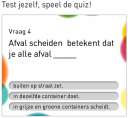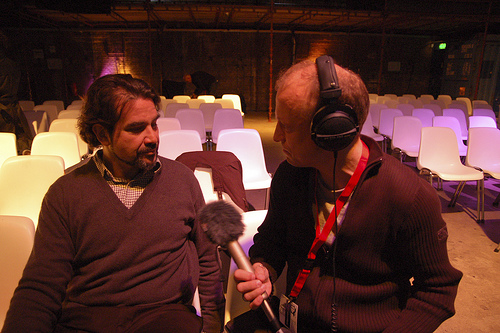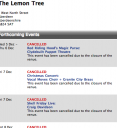Author Archive for Peter Archive Page 4
The Dutch Government launches a campaign to persuade everybody living in the Netherlands to learn Dutch. There is even a quick test on the website www.hetbegintmettaal.nl to check if you actually achieve the levels expected.
And this test is more than just about language — it is also very subtly about the Dutch way of understanding the world, as this example on recycling shows:

To separate waste means putting your waste
(a) on the street
(b) all in the one same bin
(c) into green and grey bins
(c is deemed correct)
How could I be so stupid thinking separating waste actually was about separating recyclable materials and collecting them separately for reuse…
Audio clip: Adobe Flash Player (version 9 or above) is required to play this audio clip. Download the latest version here. You also need to have JavaScript enabled in your browser.

Edward Shanken interviewed by Peter Troxler, Photo by Anne Helmond
The discussion about what stimulates innovation in the creative industries quickly touches on the topic of intellectual property rights. So far, it is commonly argued that the only solution to stimulate innovation is the legal protection of intellectual property through copyright, trade marks and similar mechanisms.
However, there is a growing number of repositories of user-generated content: YouTube, Flickr Wikipedia. They use open content models; and Creative Commons Licensing has become a popular extension to traditional copyright terms.
During PicNic I had the chance to speak to a few people about these questions, people who are all active in New Media. Using the example of Creative Commons Licensing, I discussed the potential of open content and its possible pitfalls.
With academics Rachel O‘Reilly and Edward Shanken, new media consultant Esa Blomberg, Music Futurist Gerd Leonhard, and the practitiones Hessel van Oorschot (TribeOfNoise), Gijs van de Heuvel (Nederland P), Marcus Miletich (Engerwitzdorf) and Seb Chan (Powerhouse Museum).
Denial comes in many forms, and most recently from academics from TU Berlin. A certain Prof. Erdmann claims to have discovered, that using wind energy would increase the costs of electricity in Germany by more than 0,7 Cent per kWh. Obviously it’s all to do with how you define your system boundaries; and Erdmann does that in favour of the big energy consumers and the highly centralized electricity production industry. He (or the TU Berlin press department) are so busy denying the benefits of wind energy that, in their press release, they fail to spell the weblink to the study properly (http://www.ensys.tu-erlin.de/menue/research/publications/), which I’m happy to correct here: http://www.ensys.tu-berlin.de/menue/research/publications/.
Der freundliche Kundendienst von NS (nein, nicht DAP…) sagt mir heute (auf Nachfrage wegen Geografie), sie wüssten es halt auch nicht, ich soll mich doch an NS Highspeed wenden, die seien fürs Ausland zuständig …
Emmerich ist ein mittlerweile unbedeutender Grenzort an der Bahnlinie von Rotterdam nach Köln. Versuchen wir also mal, dahin zu fahren, zum Beispiel mit der NS (nein, nicht DAP: Nederlandse Spoorwegen, die holländische Bahn). http://www.ns.nl/ ist die Adresse, Abfahrtsort ist Rotterdam Centraal, Ankunftsort Emmerich, gewünschte Abfahrtszeit: 7:45 h.
Und das ist die Reise, die NS anbietet:

… when you see one — omdat hij een externe beeldscherm gebruikt voor zijn mobiele telefoon, bijvoorbeeld
en de foto vervolgens nog op de blog plaatst
Warum Manganoxid bei hohen Drücken plötzlich zum Metall wird will uns eben ein email erklären, abends um dreiviertel elf. Der Informationsdienst Wissenschaft, die Universität Augsburg wollten’s wohl noch dringend mitteilen. “Morgen hätte das auch niemanden interessiert.” Sagt meine Frau. Und sie muss es wohl wissen, als Akademikerin.
On an otherwise unused email address I get this message with at zipped “video” file attached — no doubt the attachment will not pass the lie detector examination …
Here is the video of this patient interrogation / cross-examination. I think he doesn’t say everything.I’ll ask the psychologist to work with him. I suppose he can fall under hypnotist’s spell. Also I’ll make him to pass lie detector examination, and then we’ll compare all the information and make a conclusion. If you need me, I’m online.Gerald.
ACC announces the immediate closure of the Lemon Tree
“{ACC Resources Management} Committee members agreed unanimously that the venue should be offered the chance to take out a loan from the City Council-administered Aberdeen Business Enterprise Scheme (ABES) – or The Lemon Tree could have its overdraft facility underwritten up to a reasonable new limit by the City Council.Neither option was taken up by The Lemon Tree’s board.”
And the Lemon Tree Website is just a bunch of nested emtpy folders…. 
The Lemon Tree board had good reasons not to take up ACC offers, as comments at the Scotsman website reveal: each of the board members would have to “personally put up a guarantee of £25k from their own pockets” in order to accept that generous offer from Aberdeen City Council…
Same tune, maybe, but on another note: Plans for Aberdeen Arts Centre were rubber-stamped by city councillors yesterday, the P&J reports
“Denken für Anfänger” hat mal jemand gesagt, auf enthousiaste Vorschläge, doch ein MindMap zu zeichnen. Seither bezeichne auch ich MindMap(TM) als “Denken für Anfänger”. Mindestens seit es MindMap-Malprogramme für den Compi gibt, grassiert das MindMap Fieber allenthalben. Pseudo-sequentielle hierarchische Strukturierung, könnte man es nennen.
Im Novemberheft von ETH Globe wird Denken für Anfänger auf eine nächste Stufe gehoben, und ich zweifle, ob es eine Stufe wissenschaftlicher oder kommunikativer Inkompetenz ist. Diese Abbildung zeigt einen Ausschnitt aus einem Diagramm, das einfache Wirkungszusammenhänge darstellt — “Was tut ein Gewitter?”
Lesebeispiel führt er zu einer Überlast in der Kanalisation (overload canalisation), was zu Wasser im Keller führt (flooding, inundated cellars).
Die Legende zum Bild lautet: “Die Katastrophenkaskade eines Gewittersturms als Mindmap. Das ist es wieder, das Unwort. Und verwendet wird es diesmal für ein Bild, das eigentlich einigermassen intelligent gedacht gewesen wäre. Als ich noch studierte, sagte man bei so einem Diagramm noch: “vernetztes Denken”. Werde ich alt oder die ETH-Kommunikation schludrig? Biologisch trifft wohl Ersteres zu, intellektuell wohl eher Zweiteres …
Das behauptet zumindest dieses filmpje auf YouTube, das vom niederländischen Instituut voor Briljante Mislukkingen aufgegriffen wird.
nun, das muss man einfach wörtlich zitieren oder nachlesen, und auch das bild ist hübsch … in südafrika soll ein schwarzes nashorn flink das mietauto von zwei holländern zerdeppert haben. meldet AD. nein, wir nashörner sind *eigentlich* keine holländer-hasser. nur manchmal:

img geliehen von AD.
kommentare sagen dann auch nett:
Maybe the Rhino didn’t like the car?
misschien was het dan wel het verkeerde merk :) Het is een donkergrijze wagen dus misschien dat de Rhino het niet zo tof vond zn stalen concurrent:)
und: Zkr een vriendje van Bokito



